Ngũ Hành Sơn or Non Nước Mountains is the common name for 6 limestone mountain peaks rising behind a sandy beach, covering an area of about 2000km2. This is a famous landscape in Da Nang with its beautiful rocky scenery and many mysterious caves. In the memories of many, this is also the “spiritual land” of ancient Quang land, where the beauty of mountains, sea, as well as historical, cultural, and spiritual values converge. An attractive destination, isn’t it? Today, join Cuong on a journey to summarize the travel experience to Ngũ Hành Sơn and guide you through every detail of the itinerary for exploring and having fun at Ngũ Hành Sơn!
1. Where is Ngũ Hành Sơn located?
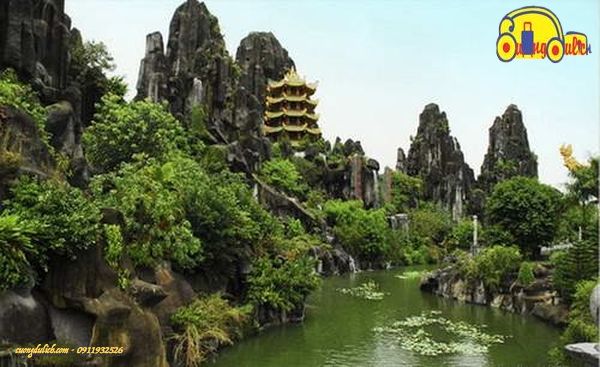
The scenic complex of Ngũ Hành Sơn is located in Hoa Hai ward, Hoa Vang district, now Hoa Hai ward, Ngu Hanh Son district, 8km southeast of the center of Da Nang, right on the Da Nang – Hoi An route.
2. How to get to Ngũ Hành Sơn?
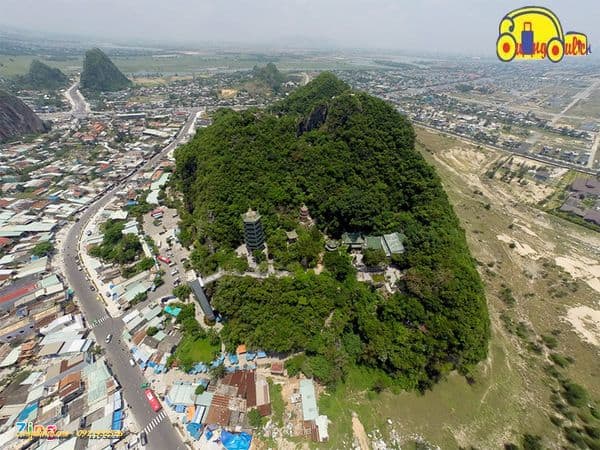
Located about 11 km from the center of Da Nang, Ngũ Hành Sơn is easily accessible. Starting from Dragon Bridge, head towards the east bank of the Han River -> turn onto Ngô Quyền Street (National Highway 14B) -> drive south. When you reach the Tran Thi Ly Bridge roundabout -> continue straight onto Ngũ Hành Sơn Street -> Lê Văn Hiến Street will lead you to the Ngũ Hành Sơn tourist area. This is the shortest and easiest route, as it mainly involves straight roads with few turns. Because the road is easy to navigate and not too far from the city center, you can use a motorbike to get here. Motorbikes can be rented in the city center at a fairly cheap price, around 100k-150k VND per day.
If you are traveling with family, taking a taxi or using a ride-hailing service like Grab is a convenient option. There are many taxi companies in Da Nang, so you can choose a safe taxi for yourself and your loved ones. Moreover, Grab services are rapidly developing in Da Nang, and many people use this type of transportation. Alternatively, you can also take a bus, which is a cheap and safe mode of transportation. To reach Ngũ Hành Sơn Mountain, take the Da Nang – Hoi An bus, which runs every 30 minutes. The fare is around 15k VND per person.
3. What is there at Ngũ Hành Sơn Mountain?
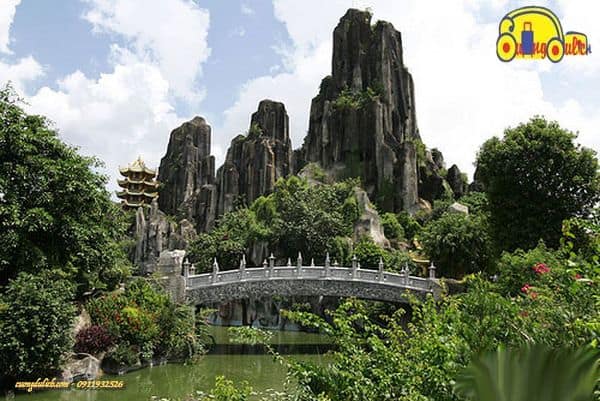
With its cool and pleasant weather and beautiful scenery all year round, Ngu Hanh Son is one of the attractive tourist destinations that you can visit at any time of the year. If you travel in the summer, besides Ngu Hanh Son, you can also combine a beach vacation in the area. Due to the mountainous terrain of Ngu Hanh Son, although not very high, the different locations and heights of the spots make climbing up and down quite challenging. The limestone mountains cover an area of about 2km2, including: Kim Son, Moc Son, Tho Son, Thuy Son, and Hoa Son. Each mountain has its own unique beauty in terms of shape, location, rock material, caves, and temples inside. Among the mountains, Thuy Son is the largest and most picturesque. The mountain is 106m high, with 3 peaks on 3 levels resembling 3 stars (Tam Thai). This is where many caves and temples are concentrated. According to geologists, the Ngu Hanh Son complex was originally small islands in the East Sea and gradually connected to the mainland after the Quang Nam plain was formed due to the uplift of the Truong Son range and the sedimentation of the Thu Bon River and its tributaries. Currently, the coast has receded about 800m from the mountain range, creating a scenic area with a unique and attractive mountain landscape. Ngu Hanh Son embodies the characteristics of Vietnamese limestone mountains, as the tropical region with abundant sunlight and rainfall causes the limestone to dissolve over time, creating incredibly mystical and enchanting scenes, especially in the caves. The caves in the Ngu Hanh Son complex are open caves with many openings connecting to the outside, making them cool and airy, unlike the enclosed caves in other places like Phong Nha, Ha Long Bay, Lang Son…
Below are some famous attractions that you should not miss when exploring this destination:
3.1. Thuy Son
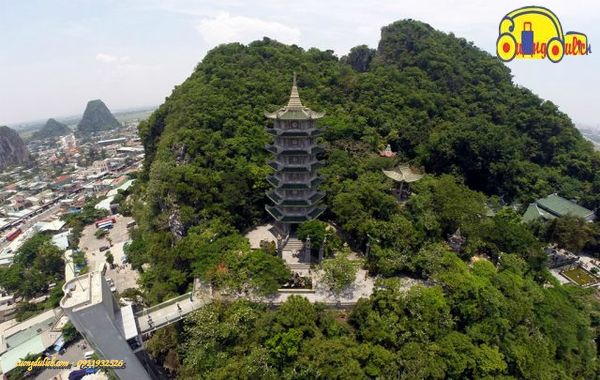
Thuy Son Mountain is the largest, highest, and most beautiful mountain among the Marble Mountains (Ngu Hanh Son) – a famous landscape in Da Nang, with a height of 106 meters and a width of 7 hectares. This place also has the most pagodas and caves among the 6 mountains in the Marble Mountains. Like the other mountains in the Marble Mountains range, Thuy Son Mountain possesses a unique beauty in terms of location, shape, rock material, pagodas, and caves. Thuy Son Mountain has 3 peaks, resembling 3 stars of the Great Bear constellation (also known as Tam Thai). Thuy Son Mountain has a beauty that combines the sea, sky, and land with deep spiritual, cultural, and historical values. There are 2 paths to reach the pagodas and caves on Thuy Son Mountain: the East gate with 108 steps leading to Linh Ung Pagoda, and the West gate with 156 steps leading to Tam Thai Pagoda. Usually, tourists will take the West gate to ascend the mountain and descend at the East gate. According to historical records, Thuy Son Mountain was the mountain that King Minh Mang visited the most. This was in the years 1825 (the 6th year of Minh Mang), 1827 (the 7th year), and 1837 (the 18th year). The two paths up the mountain were built by King Minh Mang’s order from his first visit.
The three mountain peaks include:
Upper Thai: the highest peak, located in the Northwest of Thuy Son Mountain, with Tam Thai Pagoda, Tam Ton Pagoda, Tu Tam Pagoda, Huyen Khong Cave, Hoa Nghiem Cave, Linh Nham Cave, Vong Giang Dai, Hành Cung area…
Middle Thai: located in the South of Thuy Son Mountain, with the Van Can Nguyet Quat gate, Vân Thông Cave, Thiên Long Cave, Thiên Phuoc Dia Cave…
Lower Thai: the lowest peak, located in the East, including Linh Ung Pagoda, Tàng Chơn Cave, Vong Hai Dai, Xa Loi Tower…
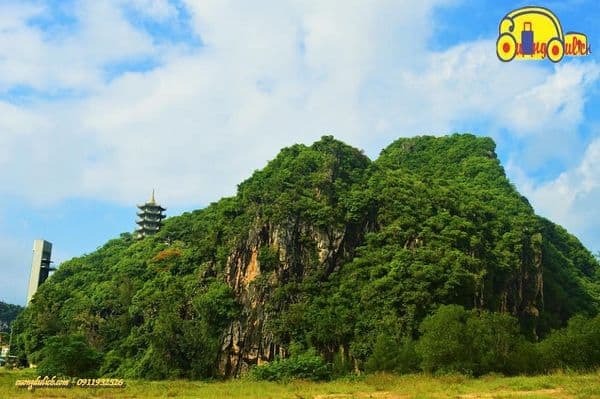
In recent years, the elevator system managed by the relic area has been inaugurated with 2 cabins, 43 meters high, speed of 1.75 m/s, and a load capacity of 1.35 T. The elevator car has a crescent shape with transparent glass walls allowing visitors to ascend the mountain while enjoying the surrounding scenery. Next to it, there is a staircase for emergency exit. The elevator can accommodate about 20 passengers per trip. The ticket price is 30,000 VND/round trip. However, many tourists still choose to walk for relaxation, immersing themselves in the picturesque natural landscape as a true outdoor excursion. Additionally, visitors can travel to Non Nuoc Beach or visit the Non Nuoc stone carving village near Thuy Son Mountain. This is where many famous stone sculptures are crafted, such as the statue of Bodhisattva Quan The Am Bo Tat at Linh Ung Son Tra Pagoda, and the statue of Shakyamuni Buddha at Linh Ung Ba Na Pagoda. Located about 8 km southeast of the center of Da Nang City, in Hoa Hai Ward, Ngu Hanh Son District. Thuy Son is situated on the beautiful and bustling Da Nang – Hoi An tourist route.
3.2. Linh Ung Pagoda
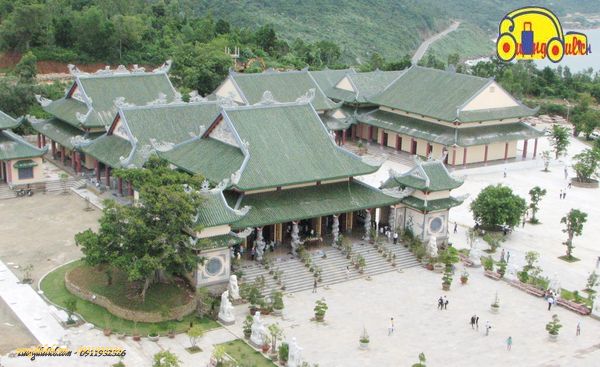
When reaching the top of Thuy Son Mountain, Cuong cannot miss the Linh Ung Pagoda on the top of Thuy Son. In the central position of the pagoda is a 10m high statue of Shakyamuni Buddha with Quan The Am Bodhisattva and Di Lac Bodhisattva on the sides. This place not only attracts many spiritual tourism enthusiasts but also allows you to immerse yourself in a peaceful place, away from the hustle and bustle of the city. Linh Ung Pagoda in Ngu Hanh Son is an ancient pagoda nearly 200 years old. Since its establishment, this famous pagoda in Da Nang has been renovated several times but still retains its ancient and tranquil beauty! Linh Ung Pagoda is also known as the Outer Pagoda, located on the east side of Thuy Son Mountain in the complex of the scenic area of Ngu Hanh Son, with Vong Hai Dai on the right, Ngu Coc Cave on the left, along with Linh Ung Bai But, Son Tra forming three pagodas with the same name Linh Ung renowned throughout the city of Da Nang and the country. This place is also a famous pilgrimage destination for tourists both domestic and international. Linh Ung Pagoda is an ancient pagoda with high historical value. In the Gia Long era, the pagoda was built and named Ung Chan, and in the sixth year of Minh Mang, it was further constructed. In 1841, King Thanh Thai changed its name to Linh Ung Pagoda. Linh Ung Pagoda has been passed down through ten generations of abbots spreading the Buddha’s teachings. This pagoda has been renovated several times, yet it still maintains its ancient and harmonious features with the natural landscape. The main statue system in the main hall of Linh Ung Pagoda in Ngu Hanh Son includes: Three Buddhas, Pho Hien Bodhisattva, Van Thu Bodhisattva, Shakyamuni Buddha, Quan The Am, Di Lac, Quan Am Chuan De, 2 Pho Ho Phap and Eighteen Arhats. These statues are meticulously crafted, each expressing its own unique characteristics but clearly showing the compassionate nature of the Buddha’s teachings. Currently, Linh Ung Pagoda in Ngu Hanh Son still preserves two rare artifacts: two golden plaques – one plaque reads “Ngự chế ưng chơn tự Minh Mạng lục niên” (the sixth year of Minh Mang’s reign) and one plaque reads “Cải Tử” meaning changed to Linh Ung Pagoda during the third reign of Thanh Thai. Behind this famous pagoda in Central Vietnam is Tang Chon Cave, 7m wide and 10m long. From Tam Thai Pagoda in the east of Thuy Son, straight up to the pagoda, at the end of the road is a large triple gate beautifully decorated. Through the triple gate is the main hall, an architectural masterpiece in the form of a single word located in the center, on the right are ancestral houses, lecture halls, guest houses, meditation halls; on the left is Quan Am Pagoda standing on the water and the towering Bao Dai tower. The pagoda’s courtyard is adorned with miniature landscapes, flowers, and vivid bonsai trees. Linh Ung Pagoda in Ngu Hanh Son has been recognized by the Ministry of Culture as a national historical and cultural relic. If you have the opportunity to visit Da Nang, do not miss this place, where there are deep mountains, vast blue skies, and a famous spiritual destination. What more could you ask for?!
3.3. Tam Thai Pagoda
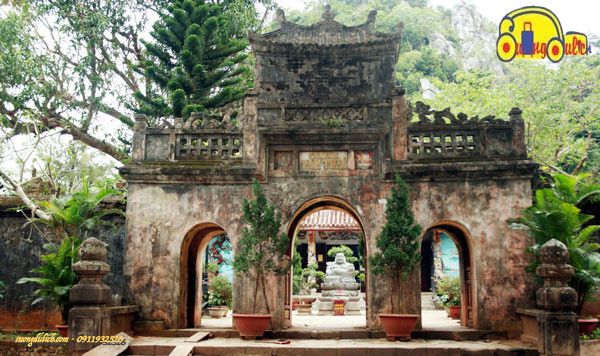
Tam Thai Pagoda is located in Hoa Hai Ward, Ngu Hanh Son District, Da Nang. It is one of the ancient temples situated on Thuy Son, one of the legendary Five Marble Mountains. Located about 13km from the city center of Da Nang, visitors can travel by car or motorbike. From Dragon Bridge, head east along the Han River and then turn left onto Ngo Quyen Street. Continue straight to Tran Thi Ly Bridge, then to Ngu Hanh Son. Here, you will see Thuy Son to the west, with 156 stone steps leading to Tam Thai Pagoda. So, prepare yourself with comfortable shoes and water to explore many places at Tam Thai Pagoda.
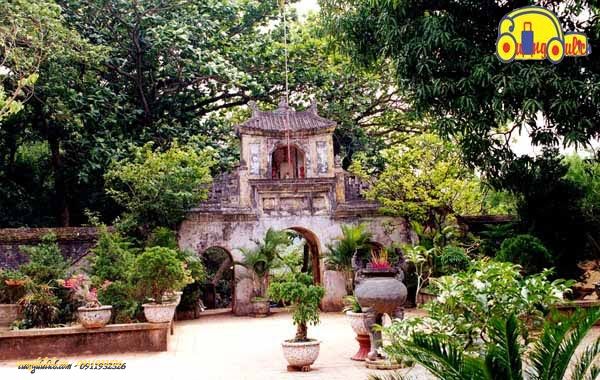
Tam Thai Pagoda was initiated in 1630 and was once the place where the Zen master Hung Lien from China came to Dai Viet to preside over this temple. The temple was rebuilt with a solemn and luxurious 3-story architecture, the first floor is Upper Thai facing north, the second floor facing south is called Middle Thai, and the third floor facing east is Lower Thai. The architecture of Tam Thai Pagoda is designed in the shape of the word “Vuong” in Chinese characters, with many artistic and highly aesthetic lines. Outside is the triple gate designed in a bell tower style with a very ancient look. In front of the temple courtyard is a statue of Buddha made of marble. Inside Tam Thai Pagoda is the statue of Amitabha Buddha, Quan The Am Bodhisattva, and the Great Compassion Bodhisattva. The place is paved with blue tiles and decorated with two dragon statues. This is considered a characteristic architecture of Nguyen Dynasty temples. When visiting Da Nang tourism, exploring Tam Thai Pagoda, visitors feel like immersing themselves in a fairyland. The romantic scenery with the cool air makes visitors forget all the worries, troubles, and hardships of present life. Today, the temple still preserves the royal decree of King Minh Mang praising the boundless compassion of the Buddha to save sentient beings. In addition, you can visit Pho Dong Tower, Tu Lam Pagoda, and Vong Giang Dai. From Vong Giang Dai, visitors can see a vast expanse of villages, rice fields, and the boundless sea. Or visit the stone carving craft villages with a history of over 400 years. Tam Thai Pagoda is like a sacred destination. It is truly a heavenly place on earth that everyone wants to find to have precious moments of peace and tranquility for the soul.
3.4. Huyen Khong Cave

Located in the highest mountain of the scenic area of Ngũ Hành Sơn (Da Nang), Huyền Không Cave is where people seek the mystical spiritual origin amidst the sacred rocky mountains. Huyền Không Cave is like a natural air conditioner on hot summer days. An ancient book from 1806 states: On the east bank of the Hoàn Ký Đông commune, there is a mountain range with five peaks named Kim, Mộc, Thủy, Hỏa, Thổ, collectively known as Non Nước Mountain. This is an attractive spiritual tourism destination in Da Nang, located about 8 km southeast of the city center. The cave is situated on the peak of Thượng Thai, one of the three peaks of Thủy Sơn and also the highest peak in the Ngũ Hành Sơn range. Huyền Không Cave is naturally illuminated, with a round ceiling, flat floor, and five holes on the ceiling to connect with the outside, allowing sunlight to flood in, making the cave appear mystical and enchanting. The entrance to the cave has a vaulted gate with the words “Huyền Không Quan,” a narrow gate with quite deep steps, and statues of the Good and Evil men at the cave entrance, serving as a reminder for people to abandon evil thoughts when entering the sacred Buddha gate. Visitors need to descend 5m behind the Hoa Nghiêm Cave, with over 20 steps, to enter Huyền Không Cave. The cave is likened to a giant overturned bell, with a circumference of about 25m, holding both spiritual and geological significance. Visiting the cave on a sunny day, with sunlight shining through the cave’s ceiling, visitors can clearly see the beauty of the jade-like rocks inside the cave. In the late 19th century, based on the marble material, the French named the scenic spot “Les montagnes de marbre” (The Marble Mountains). What sets Huyền Không Cave apart from other caves like Thiên Cung Cave, Sửng Sốt Cave (Hạ Long), Phong Nha Cave, Tiên Sơn Cave, and Thiên Đường Cave (Phong Nha – Kẻ Bàng) is its natural ventilation and sunlight, without high humidity or the need for electric lights, yet still showcasing the enchanting beauty of stalactites. Huyền Không Cave is like a natural air conditioner on hot summer days. The highest point in the cave is the statue of Buddha Shakyamuni sculpted by artist Nguyễn Chất in 1960, a renowned artist in the Non Nước stone carving village. Below the statue of Buddha Shakyamuni is an altar for Bodhisattva Ksitigarbha. To the left of the cave is a shrine for Lady Ngọc Phi (Lady Fairy), where visitors can pray for luck; and a shrine for Lady Lồi Phi (Lady of the Upper Realm), offering protection and health. Going deeper to the right, there is Trang Nghiêm Pagoda built in 1825, exuding ancient and sacred vibes. Trang Nghiêm Pagoda has three sections: the central section worships Bodhisattva Guanyin; the left section worships the three Saints Quan Công, Quan Bình, and Châu Xương, symbolizing virtue, bravery, and loyalty; and notably, the right section worships the Matchmaker and the Moon Lady, couples who often come to pray for eternal happiness. Many unique rock formations around the cave, such as the tilted face of an old man, resembling an ostrich or a stork, a two-headed elephant, a heron with a long, sharp beak… There are also strange stalactites, such as the stalactite named Mother’s Breast, which used to be wet due to moisture, but now is dry from being touched by many people. Huyền Không Cave holds historical significance alongside its spiritual meanings. It served as a secret base for local guerrilla forces during the resistance against the French. During the Vietnam War, the US military chose Huyền Không Cave as a training ground for special forces and a shelter for some US-ally units. The liberation army drove them out of this place in 1968, turning Huyền Không into a first aid station and a hiding place for wounded soldiers. On the altar in Huyền Không Cave is Thiên Y A Na – the Jade Goddess. In the past, many people came here to pray for fertility for women who were childless, then they would go inside the cave and drink water from the stalactites. Nowadays, such customs no longer exist. Huyền Không Cave is increasingly attracting more visitors along the tourist routes of Da Nang. Visit Huyền Không Cave and share your experience with Cuồng!
3.5. Động âm Phủ
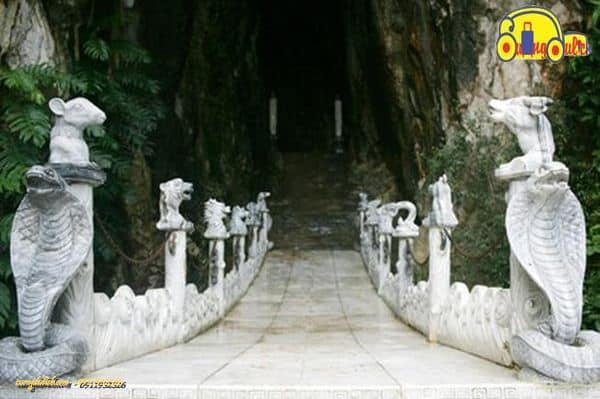
Am Phu Cave is the longest and most mysterious cave in Da Nang. Am Phu Cave is located inside Thuy Son Mountain, the cave’s ceiling is high, ranging from 45m to 50m. This is a natural cave, but the rock formations inside are arranged in a way that follows the karmic law of Buddhism, depicting scenes of what humans will experience or be punished with after death. At the entrance of the cave, there is a wall of stalactites, on the right is Mr. Thien, and on the left is Mr. Ac. Master Thich Hue Hung – who oversaw the restoration and reverence of Am Phu Cave for three years (2003 – 2006), believes that human behavior in life falls into two categories: Good or Evil. If one behaves well, they will ascend to the Heavenly Realm, a mountain path to the left of the cave entrance. If one knows how to cultivate their mind and do good deeds, they will go to worship Earth Store Bodhisattva at Earth Store Palace – the most solemn and spacious place in the cave. If one sows evil deeds, they will be sent to one of the 10 levels of hell, among which A Ty Hell is the deepest part of Am Phu Cave. Many visual representations serve as moral lessons for humans, guiding them towards goodness and away from evil. The Judgment Hall with the Heavenly Scale weighing each person’s merits/sins, behind the scale is inscribed with the words “The net of heaven is vast, yet the guilty cannot escape”. The Mirror of Karma in the Ming Wang Palace acts as an eye that observes and rewards or punishes each person’s deeds. The Repentance Altar with the image of two hands supporting a flaming heart with the word “Mind”. At the end of the cave is A Ty Prison, where the image of Muc Kien Lien, a highly accomplished monk, who, out of love for his mother Thanh De, was exiled for committing many evil deeds and made efforts to save his mother… Am Phu Cave combines harmoniously between folklore and Buddhism. The mystical legends arising from natural and human images create a framework not to evoke strong emotions in viewers but mainly to transform human nature, correct wrongdoings, and promote a beautiful human relationship network. In the theory of Yin and Yang, human life and all things always have opposites. Therefore, in Am Phu Cave, there is also a path to heaven, similar to the distinction between Good and Evil. Unlike the path to hell, the way to Heaven is a staircase illuminated by natural light. The “sky peak” area overlooks the sea. Below is the Non Nuoc handicraft village and a very poetic landscape. Visiting Am Phu Cave on Ngu Hanh Mountain, tourists not only admire the magnificent natural creation but also learn many interesting folklore stories, deeply understand profound philosophies at the Buddha’s gate.
3.6. Hon Kim Son
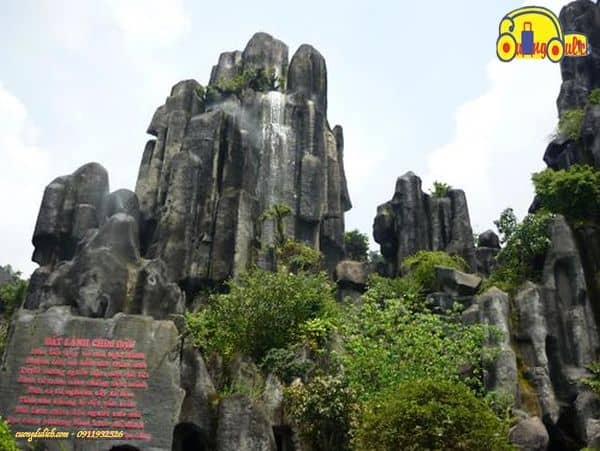
Hon Kim Son is the most modest mountain among the 6 mountains stretching from east to west, the Truong River extends to the Da Nang River, with a ferry dock where kings and lords used to visit to admire the scenery. Over time, the sea turned into fields, the Truong River, also known as Lo Canh Giang, the Co Co River, has been buried and turned into fields or water reservoirs, with traces of sections of the river that have not been completely filled.
Here there are 02 temples and 02 caves: Quan The Am Pagoda and Quan Am Cave, Thai Son Pagoda and Tam Thanh Cave, Quan The Am Pagoda is currently being expanded and has a very large stone temple, including the Buddhist Cultural Museum – the first Buddhist museum in Vietnam located in the 700m2 area of Quan The Am Pagoda; Currently, the museum is displaying over 200 artifacts crystallizing unique cultural values including: Quan Am Bodhisattva statue escorting the dead, Quan Am Bodhisattva riding a dragon fish, many ancient statues like Thich Ca, Medicine Master, Di Lac, Maitreya Bodhisattva, Quan Am, Champa, Di Da, bronze bells, the set of eight auspicious symbols, etc.
In addition, the temple is also preserving many artifacts such as Buddha statues, wooden Buddhist scriptures, ancient bronze items, worship items, etc., dating back from the 7th century to the end of the 19th and 20th centuries…
3.7. Hon Hoa Son
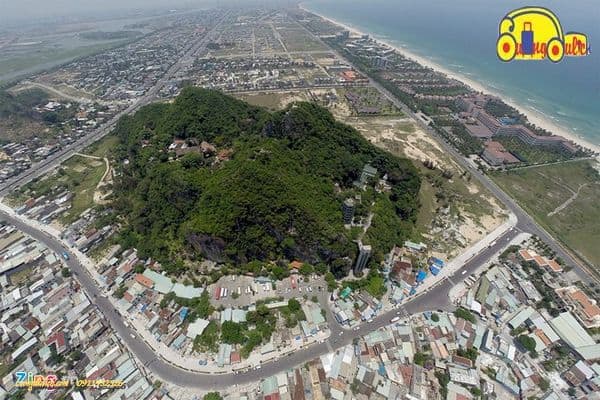
Hỏa Sơn is located in the southwest, opposite Kim Son Island, to the left of Su Van Hanh Street. In the past, the Co Co River ran along the south side of Hoa Son Island, now only a narrow strip of water connecting the remaining sections of the Ba Cha and Bai Dai rivers at the beginning and end of Hoa Hai Ward. This is a twin island, consisting of a Yin island and a Yang island, connected by a high natural stone path. In the middle of this path is the Ung Thien Pagoda.
Yin Hoa Son is located to the east, near Le Van Hien Street, with a round mountain peak rising higher. The mountain slope has many inclined rock layers, with trees growing in the crevices between the rocks. On the eastern side of the mountain, there is a cave that goes from the southern slope to the northern slope. There are no caves in Yin Hoa Son. At the foot of the mountain, there is a stone slab engraved with 6 characters: Pho Da Son Quan Yin Temple. Therefore, Yin Hoa Son is also known as “Pho Da Son,” because in the past there was a temple dedicated to Bodhisattva Quan The Am.
Yang Hoa Son (locally known as “Ong Chai Mountain”) is located to the west. In the past, when there was still waterway transportation between Hoi An and Da Nang, there was a river port here, bustling with boats trading. On the riverbank, near the foot of Yang Hoa Son, there was the Ong Chai Temple, which is now in ruins. The local name “Ong Chai Mountain” may have originated from this. On Yang Hoa Son, there are two ancient temples: Linh Son Temple and Huyen Vi Cave, Pho Da Son Temple and Cave. The mountain peak faces southwest, with steep slopes and very quiet caves. This place also has the ruins of Cham people’s temples and towers.
3.8. Tho Son Island
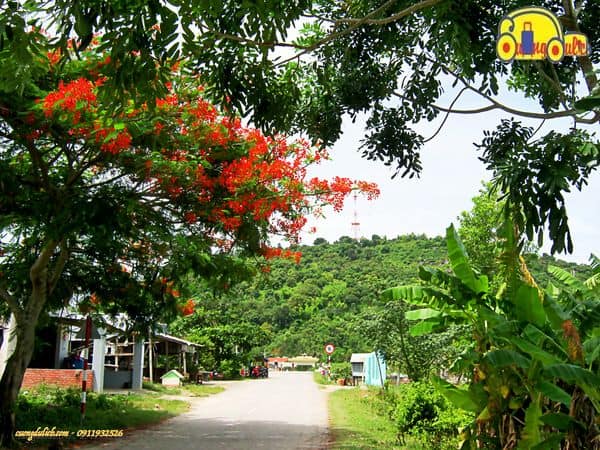
Hòn Thổ Sơn is a low mountain located in the middle with a square shape, uneven edges, Tho Son does not have beautiful scenery, only red clay and mixed sandstone. According to legend, Tho Son is the sacred land where the people of Chiem Thanh used to reside, and traces of Chiem Thanh civilization can be found carved into the rocks as a diary from which they set out to raid the seas where Chinese merchant ships sailed from China to the Malay seas. Tho Son is surrounded by taller mountains. On Tho Son, there are 04 pagodas and 01 tunnel:
* Pagodas:
Long Hoa Pagoda
Hue Quang Pagoda
Huong Son Pagoda
Giac Hoang Vien Pagoda
* Tunnel:
Rock mountain tunnel
3.9. Thap Xa Loi
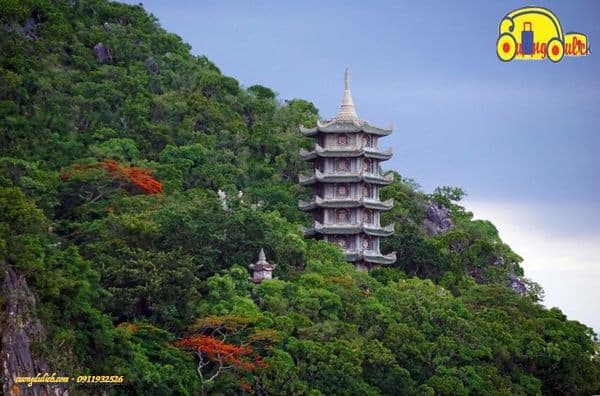
Tháp Xá Lợi is located on the eastern slope of Thuy Son Mountain, construction began in 1997 and was completed in 2004. The tower is named Xa Loi (Xa Loi Tower) with the purpose of building a tower to worship the miraculous crystallization of spiritual achievement, the ultimate development of compassion and wisdom. According to Buddhist history, when Buddha Shakyamuni entered Nirvana, his disciples performed a tea ceremony, and after the fire went out, they discovered many transparent crystals in the ashes, of different shapes and sizes, hard and sparkling, emitting colorful rays of light, resembling precious gems. The disciples counted 84,000 gems, stored in 8 compartments and 4 boxes. These objects were named Xa Loi, the treasure of Buddhism. Buddhists believe that enlightened practitioners also leave behind Xa Loi after performing the tea ceremony. Xa Loi Tower, with 7 floors, is about 28m high hexagonal shape. It combines various architectural styles harmoniously, such as Thai-style spirals on the tower’s peak, Vietnamese-style curved roofs, ancient Greek-style columns… The tower’s architecture with 7 floors, 6 sides carries certain meanings in Buddhism such as seven emotions, six paths, six roots, six thieves… Many people believe that the number 7 is a lucky number, so the tower was built with 7 floors, which is probably true when we understand the significance of this number. According to Buddha Shakyamuni’s teachings, all joy, sorrow, happiness, and suffering in this world are due to our perception and interaction with the external environment. Currently, on the 1st floor of Xa Loi Tower, there are statues of Buddha Shakyamuni, Ananda, and Mahakasyapa, the first two disciples of Buddha. In addition, the tower also worships all 18 Arhats and all the bodhisattvas in the Great Compassion Mantra. The 7th floor houses the precious gem of Xa Loi Buddha. Xa Loi Tower is not only beautiful in harmonious architecture, carrying important meanings of Buddhism, but also conveniently located to enhance the eastern slope of Thuy Son Mountain. The courtyard of Xa Loi Tower is now connected by a bridge leading to an elevator. At this location, visitors can enjoy the beautiful scenery of the East Sea, Cu Lao Cham Island, Son Tra Peninsula, and almost the entire panorama of the Marble Mountains, surely somewhat dispelling the fatigue of daily life’s worries.
3.10. Vọng Hải Đài
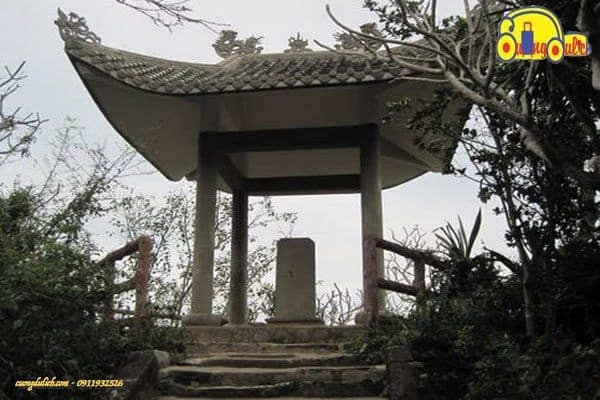
Vọng Hải Đài is located at the peak of Ngu Hanh Son mountain, Da Nang, where in the past King Minh Mang visited Non Nuoc Pagoda for pilgrimage, used this place to rest and admire the beautiful and charming scenery. With this beautiful view, the king named it Vọng Giang Đài and had a commemorative stele built. Standing here, visitors can observe the vast sea and see Cham Island to the southeast. From the top of Vọng Hải Đài, looking into the distance, you can see the ancient Co River winding northward and merging into the beautiful Han River flowing towards Da Nang Bay and out to sea at Tien Sa Port. Along the river, the water has provided the surrounding people with abundant resources for daily life, agriculture, aquaculture, and more. Today, when climbing Ngu Hanh Son mountain and stopping at Vọng Hải Đài, admiring the vast sea and many famous landscapes such as My Khe Beach, My An Beach, blending into the Non Nuoc area with the historical park of Ngu Hanh Son. When traveling to Ngu Hanh Son, on Vọng Hải Đài, you will feel the spiritual atmosphere, the area dedicated to fairy deities, Buddha saving sentient beings, with a serene landscape, allowing visitors to escape the hustle and bustle of life, try it once and you will see it clearly.
3.12. Vọng Giang Đài
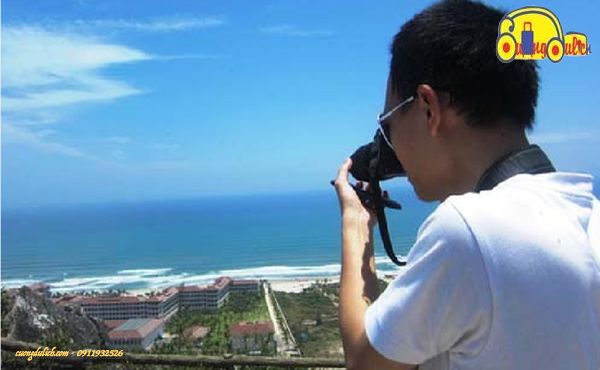
Vọng Giang Đài or River Overlook Tower is located on the southwest side of Thuy Son Mountain, offering a high vantage point to view the Cam Le River, Co Co River, and the entire Ngu Hanh Son mountain range. The path leading up to Vong Giang Dai is across from the ancestral house area of Tam Thai Pagoda, with a narrow path lined with natural stone steps. The river overlook tower has a circumference of about 7 meters, with a stone Trà Kiệu tablet in the center, measuring about 2 meters high and 1 meter wide, mounted on a large stone base. The tablet is inscribed with 3 Chinese characters reading Vong Giang Dai, and next to it, a smaller inscription states the date the tablet was erected: “Minh Mang thap bat nien chat nguyet cat nhat” (meaning Minh Mang on the 18th day of the 7th lunar month in the year 1837).
Standing at Vong Giang Dai, visitors can enjoy panoramic views of the landscape below, with the stone carving village surrounding the base of the mountains, the winding Co Co River, and the rice fields, creating a picturesque rural scene. In the distance, the majestic Truong Son mountain range adds to the beauty of the natural scenery. Currently, a square house has been built at the river overlook tower to provide shelter from the sun and rain for visitors while also protecting the stone tablet.
4. What to do at Ngu Hanh Son?
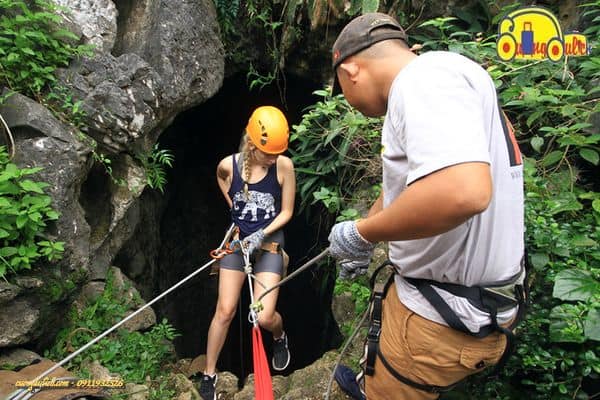
Here you can rock climb at Ngu Hanh Son, which will open up an exciting journey of exploration for those who love challenges. The rock climbing and rappelling services to explore the Ngu Hanh Son caves are provided with a professional guide. Whether you are experienced or not, as long as you have a spirit of adventure, you will surely overcome all challenges with the professional guidance of the trainer, from basic things like using ropes, safety equipment, to climbing techniques. Many foreign visitors are very excited to participate, enjoying the magnificent scenery from the marble mountains and exploring the mysterious caves, while challenging themselves and improving their health.
5. Ticket Prices for Visiting Places in Ngu Hanh Son
Here are some ticket prices for your reference:
5.1. Thuy Son Peak
Adults: 40,000 VND/person
Students: 10,000 VND/person
Children under 6 years old: Free
5.2. Am Phu Cave
Adults: 20,000 VND/person
Students: 7,000 VND/person
Children under 6 years old: Free
6. What to Eat in Ngu Hanh Son?
6.1. Quang Noodles
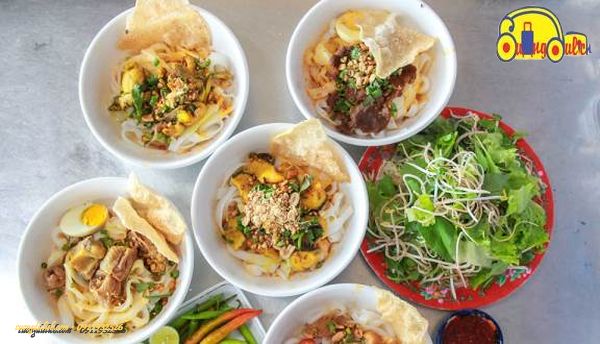
Mì Quảng is a dish quite familiar to people in Da Nang, when in Ngu Hanh Son, ordering a bowl of Mì Quảng brings a rustic flavor, like a bowl of hometown noodles creating a sense of familiarity, closeness, with smooth white noodles, tenderly blending with the sweet and rich taste of the broth, what could be better
Cuong would like to introduce some delicious Mì Quảng restaurants in Ngu Hanh Son:
Mì Quảng Dung (43 Ngu Hanh Son), Mì Quảng Phương (06 Phan Tu), Mì Quảng bà Vị (60 Ngu Hanh Son) or Bà Mua restaurant (40 Ngu Hanh Son… price 20k/bowl.
6.2. Seafood
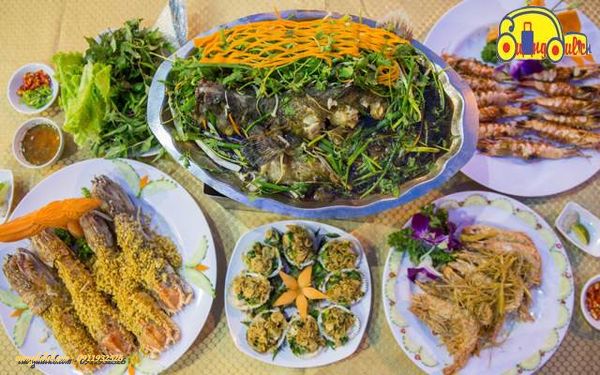
When visiting the beach, not enjoying seafood is a real miss, right? Fresh and diverse seafood (shrimp, crab, squid, clams…) at Ngũ Hành Sơn is also very affordable for your wallet. Some seafood restaurants that Cuồng recommends for their delicious food and great views include: Hải Sản A Tý (at 2 Trường Sa), Hải Sản Bình Dân 2 Tâm (Lots 12-13 Trường Sa), Hải Sản Cu Nhật (23 Ngũ Hành Sơn)…
6.3. Bánh xèo

Banh xeo with shrimp, meat, bean sprouts.. wrapped in a crispy crust served with fresh vegetables, dipping sauce, is a simple yet flavorful dish, when visiting Ngu Hanh Son, you can check out some delicious banh xeo places such as: Mrs. Huong’s banh xeo (141 Ngu Hanh Son), Banh Xeo Xuan (04 Phan Tu), Mrs. Muoi’s eatery (23 Chau Thi Vinh Te).
You can also explore other delicious eateries like: Mrs. Hai’s crab noodle soup (K25/14 Ngu Hanh Son), Mrs. Sau’s fish sauce noodle soup (93 Ho Xuan Huong), Mr. Ly’s grilled beef (328 Ngu Hanh Son), 3 Delicious Beef (262 Le Van Hien),…
Ngu Hanh Son Video
7. Some special notes when visiting Ngu Hanh Son
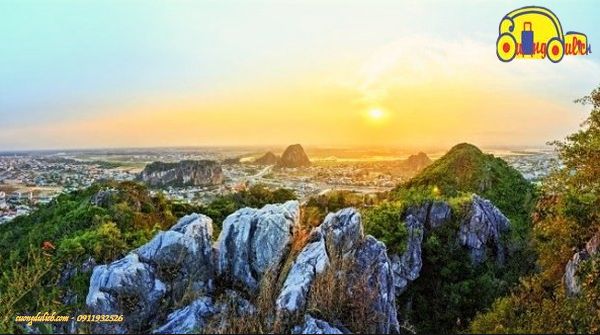
+ Ngu Hanh Son Mountain is not too large or high, but it is still a mountainous terrain, so moving around should be done calmly. The paths are rocky with moss in many sections, quite slippery, especially on rainy days. Pay close attention to this!!!
+ When climbing the peaks, especially Thượng Thai, the paths are narrow, steep, with some handrails but not large, so you need to be careful while moving.
+ For elderly people, it’s recommended to use the elevator for moving around, as the path up at gate number 2, although not far, is extremely slippery.
+ To fully understand and appreciate the beauty of Ngu Hanh Son, it’s advisable to hire a tour guide to introduce you to this place. Or as I often share, you can join a tour group and “eavesdrop”. Ngu Hanh Son is extremely beautiful when understood in terms of its history.
+ At gate number 2, there are many souvenir items for sale, including carved stones. If you want to buy souvenirs, you can do so here. And remember to bargain, feel assured, the locals here are not as unpleasant as those in the North.
Above is a travel guide to Ngu Hanh Son that you shouldn’t miss when visiting Da Nang. Hopefully, with Cuong’s sharing, you will have an interesting trip to explore Ngu Hanh Mountain.
